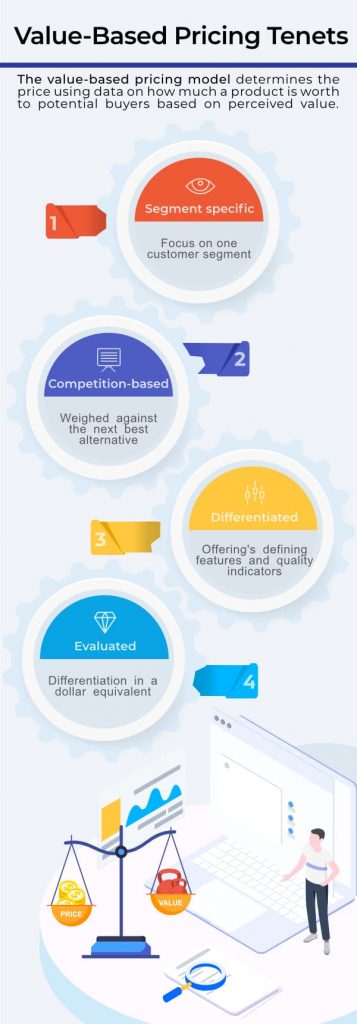One of the key challenges businesses face today is choosing a pricing strategy that is right for their product or service. When it comes to business pricing models it’s easy to turn to tried and true strategies like cost-plus and competition-based pricing as the go-to options. However, product pricing can depend on more than just production costs and competitor averages. This is where value-based pricing comes into play.
Modern market strategies prove that businesses that succeed are those that manage to create and maintain customer loyalty. To truly do so, businesses need to uncover the value their product, or the deliverables of their service, brings to customers. In other words, they can determine the pricing approach based on how much it is worth to buyers.
The following guide will illustrate the mechanisms of value-based pricing, how VBP is calculated and how business can benefit from using the strategy.
Definition of value-based pricing
The value-based pricing model determines the price using data on how much a product is worth to potential buyers based on perceived value. That value is gauged through how the product or service’ benefits the customer by satisfying their needs and expectations. It also takes into consideration how valuable customers perceive your product or service features to be compared to similar market offerings.
VBP is about unearthing data on how much the customer actually values what the business offers.
It’s worth noting, the approach does not incorporate brand value, or the prestige that your brand name adds to what you are selling.
How value-based pricing works
Where the cost-plus model looks at the overall production costs—labor, raw materials, and general overhead— and the desired profit margin, and the competitive pricing uses the average market rate, value-based pricing looks at the pricing problem from a different angle.
In essence, the strategy relies on four tenets:
Segment specific.
Businesses focus on their target market to determine the price. Buyer personas and research data can help pinpoint how a particular segment of customers evaluates a presented price.
Competition-based.
For method to work, it is crucial to screen against competing products and services. If the offering is entirely new to the market and has no evident alternatives, it will be much harder to fathom what it is worth for the target market.
Differentiated.
Provided the offering is not one of a kind, the provider must determine its unique selling point. In other words, this means listing the perks and features that make it different to the competittor’s offering.
Evaluated.
Once the unique selling point, or points, are determined, the business can proceed to calculating the worth of these differentiated features. By assigning a monetary value to the things that make the product stand out, a business can triangulate on pricing that works.

In view of the above points, it becomes clear that for the pricing strategy to work, businesses will need to obtain data. It comes highly recommended to conduct qualitative customer analysis, market research, and competitive analysis in order to arrive at a price that does not misfire and sits well with your buyers.
Worth noting that Business-to-Business and Software-as-a-Service companies stand to benefit from leveraging a value-based approach in particular. For them, cost-plus and competition-based strategies will disregard production costs that vary in terms of labor depending on geography, and the cost-value ratio can differ significantly.
How is value-based pricing calculated?
Calculating product price using the value-based pricing approach is relatively straightforward. It is the customer surveys and market intelligence gathering that often is not. Whatever the case sales people and marketers working on pricing strategies need to be wary of the customer segment they are solving for.
When surveying your customers and potential markets it is crucial to conduct research per segment. This both avoids diluting results and getting an erroneous estimate, but also saves the business in potential losses from missed opportunities.
In terms of the math, the formula looks like this:
Ready to pay= Production cost + Profit margin
When evaluating the price of product or service features businesses should also bear in mind that not all features are the same. Some may be considered essential and will have a low price point in terms of value, as the customer will expect these to be part of the essential package. Head over to HBRs post to learn more about common value-based pricing misconceptions.
Value-based pricing examples
Whatever your product or service, be it digital or traditional, offline or online— the value-based approach is applicable across the board. Let’s look at value-based pricing examples through the lens of the mobile phone market. Our products will be the usual suspects, Apple and Samsung, with market newcomer OnePlus thrown into the mix.
Apple has long been considered a boutique brand, one that offers slick products at premium prices. It is no secret that iPhones, developed in the same factories as Samsung devices, have a higher price tag due to brand value, rather than product value.
The Samsung brand name, on the other hand, has become synonymous with high-end devices. Its smartphone offering is recognized for feature-rich, bleeding edge devices. Incidentally, it is this that has allowed Samsung to practically level the price of its devices with those of Apple.
Up-and-coming phone maker OnePlus, became an overnight success using a different strategy. It engineered phones that rivaled those of Apple and Samsung, but sold at almost half the price. This type of pricing is known as penetration pricing and it helped the phone maker rapidly capture market share. At later stages, value-based model helped the company increase margins, while retaining customer loyalty. A OnePlus pricing study shows the company gradually transitioned to value-based pricing with newer products as perceived value increased in the eyes of the buyers.
The OnePlus story is a great illustration of how the approach can be applied to capture market share. It also goes to prove that businesses can mix and match strategies depending on their goals. Similarly to OnePlus, both Apple, and recently Google, has adopted new pricing strategies that introduce lower priced products, like the latest iPhone SE and the Google Pixel 4a respectively, to win back the market. Though, in this case, it probably has more to do with a blended pricing approach, or a mixed pricing strategy.
How a value-based contract can help your business
Businesses would be wise to remember that value-based pricing is not a cure-all. Just because a business thinks that by pricing higher, they can increase margins, the result will not always play out in their favor. At the same time, pricing too low might mean you are leaving money on the table and yielding positions to competitors.
For the pricing strategy to truly shine, it needs to work in tandem with value-based selling and a marketing approach that highlights the unique value proposition. Last but not the least important, of course, is conducting rigorous market research to recognize demand, get a feel for the market, and measure against the competition.
All in all, VBP has clear-cut benefits for businesses that choose to adopt it. One such benefit is facilitating quick market entry if the product offers something unique or differentiated, as compared to alternatives.
Additionally, companies can benefit from higher markups and resulting revenue, provided they have been diligent with their market intelligence and research. Ultimately, value-based pricing also easily lends itself to being used with other pricing models. It therefore serves as a doorway to securing market dominance and is flexible enough to meet business goals and adapt to market changes.
Conclusion
It is fair to note that it may have lost its way to other models in recent years. Freemium pricing has gained widespread recognition with the emergence of digital products and services, such as mobile applications. Though, businesses will likely adopt a combination of value-based pricing in conjunction with another approach as part of its overall market strategy, as opposed to a single approach.
As far as dynamic pricing models go, value-based pricing might not always make the top five list. But in most cases, the pricing strategy is tacitly understood to be viable and is widely used in some shape or form by most modern companies.
Moreover, the approach is not confined to a single type of product or service. It can be applied beyond the digital domain, extending as far as freelance work, healthcare services, and even software development. Therefore, those looking to pivot their business to be more competitive in the modern market have plenty to gain from endorsing the value-based pricing strategy.
07 September 2020

 Pavel Kaplunou
,
Pavel Kaplunou
, 



